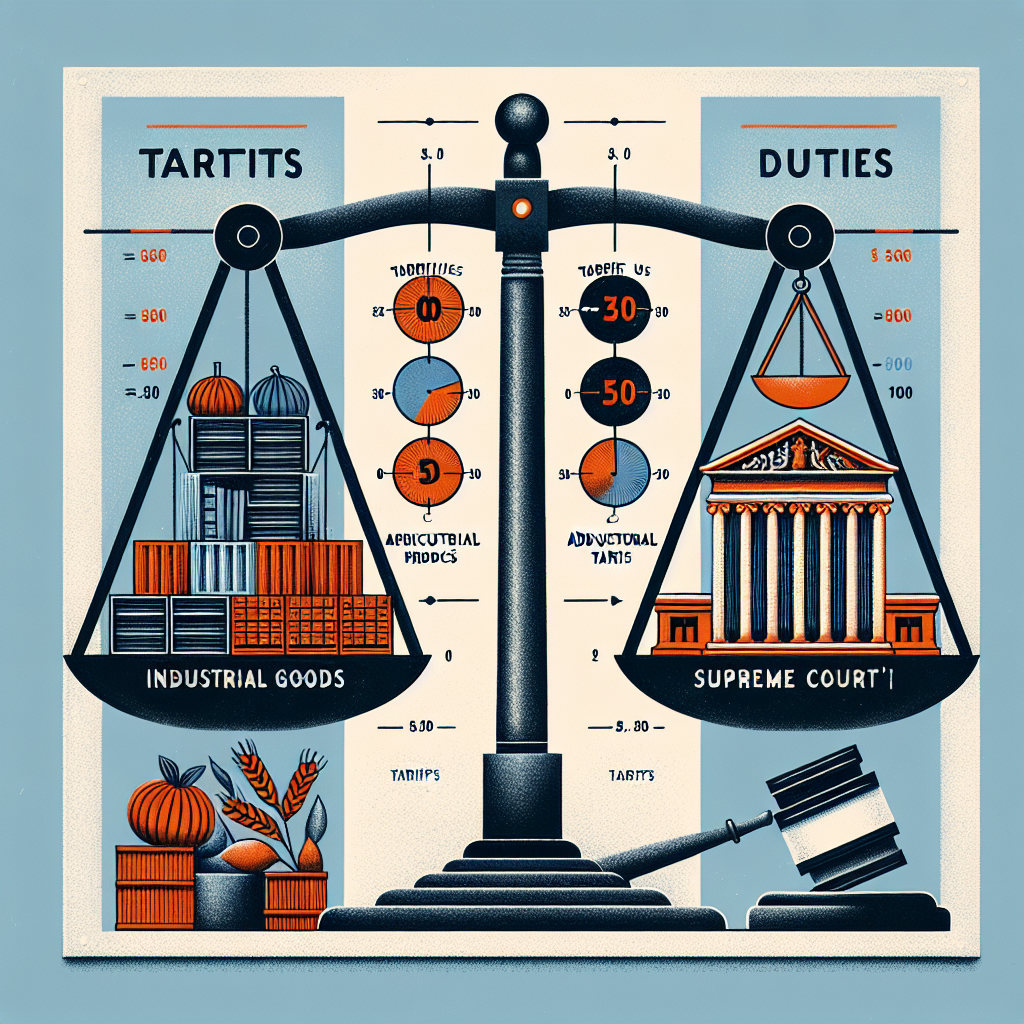In the complex landscape of American economic policy, President Donald Trump’s administration introduced a significant shift with the announcement of new tariffs during what he termed “Liberation Day.” This unprecedented move not only had immediate repercussions on global markets but also set the stage for a legal battle that would reach the Supreme Court. As the legal framework surrounding tariffs comes under scrutiny, the case of Learning Resources v. Trump raises pivotal questions about the extent of presidential powers in regulating international trade.
Understanding Tariffs and Presidential Powers
At the core of the discussion is the International Emergency Economic Powers Act of 1977 (IEEPA), which grants presidents expansive authority to manage trade in the face of national emergencies. This act empowers the president to investigate, regulate, or prohibit imports when a national emergency is declared. However, the terminology used in the IEEPA does not explicitly mention tariffs or taxes. The Trump administration argues that the president’s power to “regulate” imports implicitly includes the authority to impose tariffs, a claim that raises significant constitutional questions.
Legal experts, including law professor Jack Goldsmith, highlight the constitutional distinction between the power to regulate trade and the power to impose taxes on it. This distinction is critical as it underscores the limitations of executive power in economic matters. As the Supreme Court prepares to hear the case, the justices will need to consider whether the executive branch can equate regulation with taxation, a point of contention that could reshape the boundaries of presidential authority.
The Supreme Court’s Role in Trade Regulation
The upcoming Supreme Court hearing on November 5 will not only address the specific legal question of whether tariffs fall under the president’s regulatory powers but also set a precedent for future executive actions concerning trade. The implications of this case extend beyond tariffs, potentially affecting how future administrations manage international trade relations. As the legal arguments unfold, observers will be keenly watching how the court interprets the IEEPA and the separation of powers within the federal government.
Moreover, the outcome of the case could influence public perception of presidential authority in economic policy. If the court upholds the administration’s interpretation, it may embolden future presidents to take similar actions without congressional approval. Conversely, a ruling against the administration could reinforce the legislative branch’s role in regulating trade and curtail executive overreach.
Potential Outcomes and Their Implications
The implications of the Supreme Court’s decision on tariffs and presidential powers are far-reaching. A ruling in favor of the Trump administration could set a precedent for expansive executive powers, allowing future presidents to implement tariffs more freely under the guise of regulation. This shift could lead to increased volatility in international markets, as tariffs become a more common tool in the executive arsenal.
On the other hand, a decision against the administration would reaffirm the traditional checks and balances between the legislative and executive branches. Such a ruling could limit the president’s ability to impose tariffs without congressional oversight, ensuring that significant economic decisions are subject to legislative debate and approval. This outcome would align with the foundational principles of American governance, where power is distributed to prevent any single entity from wielding excessive control.
| Aspect | Trump’s Position | Supreme Court Consideration |
|---|---|---|
| Authority to Impose Tariffs | Argues it falls under regulation | Must determine if regulation includes taxation |
| Impact on Trade Policy | Supports unilateral action | Could redefine executive powers |
| Legal Precedent | Potentially expansive | May limit or expand executive authority |
As the case unfolds, it will be crucial to monitor the legal arguments presented and the justices’ interpretations of the IEEPA. The Supreme Court’s decision will not only impact the current administration but also set a lasting precedent for how tariffs are viewed under American law. Legal scholars and political analysts alike will be examining this case closely, as it could shape the future of economic policy in the United States. For further insights on the implications of this case, consider exploring the discussions surrounding trump v. anderson and the recent trump assailant verdict.
The intersection of President Trump’s tariffs and the Supreme Court’s interpretation of duties presents a complex legal landscape that is currently being scrutinized. As the upcoming case, Learning Resources v. Trump, approaches, it raises significant questions about the extent of presidential powers regarding trade regulation. The implications of this case extend beyond economic policy and touch upon constitutional interpretations of authority, particularly concerning tariffs and taxation.
Presidential Powers Under the IEEPA
At the heart of the debate is the International Emergency Economic Powers Act (IEEPA) of 1977, which grants the president broad authority to respond to national emergencies. Under this act, the president can investigate, regulate, or prohibit imports when a national emergency is declared. However, the statute does not explicitly mention the imposition of tariffs or taxes. Instead, it uses the term “regulate,” which has led to differing interpretations regarding the scope of this power. The administration contends that the ability to regulate trade inherently includes the authority to impose tariffs, a stance that is being challenged in court.
Legal scholars, such as law professor Jack Goldsmith, argue that the distinction between regulation and taxation is crucial. The U.S. Constitution clearly delineates between the powers to regulate trade and the powers to impose taxes, duties, imposts, and excises. This distinction raises critical questions about whether the president’s actions can be classified as regulatory or if they overstep into the realm of taxation. The outcome of this case could redefine the balance of power between the legislative and executive branches concerning trade policy.
Legal Precedents and Implications
The Supreme Court’s decision in this case may set a precedent that impacts not only tariffs but also the broader scope of executive power in economic matters. The court’s interpretation of what constitutes regulation under the IEEPA could have far-reaching consequences for future administrations. If the court sides with the administration, it may embolden future presidents to impose tariffs without explicit congressional approval, potentially undermining legislative authority in economic policy.

Moreover, the implications of this case extend to various sectors of the economy, as the uncertainty surrounding tariffs has already affected market stability. For instance, amazon vs. U.S. government illustrates how regulatory decisions can influence the operational landscape for large corporations. As businesses navigate the complexities of tariffs, their responses to potential changes in regulation will be critical in shaping economic outcomes.
As the court prepares to hear arguments, the legal community is closely monitoring how justices will interpret the president’s authority under existing statutes. The ruling will not only affect the current tariff landscape but may also redefine the parameters of executive power in the context of trade regulation. This evolving legal framework will likely influence how future administrations approach economic policies.
The Role of the Supreme Court
The Supreme Court’s involvement in this case underscores its critical role in interpreting laws that govern economic policy. The justices will need to consider the historical context of the IEEPA and its intended purpose when evaluating the president’s powers. Furthermore, the implications of their ruling could reverberate throughout the judiciary, influencing lower courts in similar cases.
As the legal arguments unfold, the court may also take into account public sentiment and the economic consequences of its decision. The trump v. anderson case highlights how public opinion can intersect with judicial proceedings, potentially impacting the justices’ considerations. The outcome of Learning Resources v. Trump may not only determine the fate of current tariffs but also shape the future landscape of trade law in the United States.
The legal dispute surrounding President Trump’s tariffs and their constitutionality is set to unfold in front of the Supreme Court. The implications of this case extend beyond tariff policy; they touch on the fundamental powers granted to the presidency and the authority of Congress in regulating international trade. As the court prepares to hear Learning Resources v. Trump, the focus will shift to the interpretation of the International Emergency Economic Powers Act (IEEPA) and how it relates to the imposition of tariffs. This case may redefine the boundaries of executive power in economic matters, which have become increasingly contentious in the current political climate.

The Legal Framework of Tariffs and Executive Power
At the heart of the case lies the IEEPA, which empowers the president to address national emergencies by regulating imports. The statute, enacted in 1977, does not explicitly mention tariffs or taxes, leading to a significant debate over whether the president’s regulatory authority encompasses the ability to tax imports. Critics of the administration’s position argue that the Constitution clearly delineates the roles of taxation and regulation, suggesting that the imposition of tariffs should rest with Congress, not the executive branch. However, the administration contends that the power to regulate includes the authority to impose tariffs as a tool for achieving its economic objectives.
Legal experts, including law professor Jack Goldsmith, highlight the complexities inherent in this argument. The distinction between regulation and taxation may not be as clear-cut as it seems. In practice, tariffs function as a form of regulation on trade, affecting the prices of imported goods and thereby influencing market dynamics. This nuanced interpretation raises critical questions about the scope of presidential powers and the role of legislative oversight in economic policy.
Implications for Future Trade Policy
The outcome of this case could set a significant precedent for future trade policies and the extent of executive authority. If the Supreme Court sides with the administration, it may embolden future presidents to exercise similar powers without congressional approval, potentially leading to an era of heightened executive control over trade. Conversely, a ruling against the administration could reaffirm the necessity of legislative involvement in tariff imposition, thereby reinforcing the checks and balances that govern U.S. economic policy.
As the court deliberates, stakeholders across various sectors are closely monitoring the proceedings. Businesses that rely on international trade are particularly concerned about the potential for increased tariffs and the uncertainty that such policies create. The legal arguments presented will not only shape the immediate outcome of this case but will also influence the broader landscape of U.S. trade relations. The implications of executive overreach in tariff policy could reverberate through the economy and impact global trade dynamics.
In conclusion, the Supreme Court’s decision in Learning Resources v. Trump will likely have lasting effects on the balance of power between the presidency and Congress regarding trade regulation. As the legal community and the public await the court’s ruling, the case serves as a crucial reminder of the intricate relationship between law, economics, and governance in the United States. For those interested in the intersection of law and politics, the trump administration corruption has also raised important questions about accountability and the integrity of governmental institutions, further complicating the landscape of American governance.